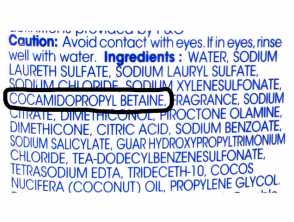What is cocamidopropyl betaine?
Cocamidopropyl betaine (CAPB) is a naturally-derived product of coconut oil, found as a viscous liquid.
Cocamidopropyl betaine is most often used in personal care products as a cleansing ingredient, due to its ‘surfactant’ property – like soap, it breaks the surface tension of water, allowing dirt to rinse away. During manufacturing, it is blended with other elements such as dimethylaminopropylamine (DMAPA) and amidoamine (AA).
Cocamidopropyl betaine
Where is cocamidopropyl betaine found?
Due to its surfactant and thickening action, CAPB is used in a wide range of personal care consumer products. These include:
- Shampoos, conditioners, and soaps
- Makeup remover and cleaning wipes
- Shaving cream
- Contact lens solutions
- Some toothpastes
- Some cosmetics.
CAPB is also a common ingredient in household spray cleaners and detergent wipes.
What are the clinical features of cocamidopropyl betaine allergy?
Allergy to cocamidopropyl betaine is more common in women, and has a diagnosis rate of 6% in an Australian population of individuals suspected to have allergic contact dermatitis.
People who are sensitised will develop contact dermatitis (eczema). The features of contact dermatitis are:
- Red rash
- Itching
- Swelling
- Vesicles/blisters.
This will develop where skin contact has occurred:
- Commonly on the face and hands
- Eye irritation may also occur i.e. eye pain/irritation, redness, and itching.
Am I allergic to cocamidopropyl betaine?
Diagnosis can be confirmed with a dermatologist using patch testing. Sensitised individuals will develop a positive result.
During patch testing, patches are applied to the skin, containing allergens in chambers. Tests are usually read at 48 and 96 hours after application of the allergen.
Cocamidopropyl betaine is tested as 1.0% aqueous solution. Patients may be asked to bring personal care materials from home for testing that are suspected of causing the contact allergy. Labels can also be inspected to assist with allergen identification.
How is cocamidopropyl betaine allergy treated?
Any identified product containing cocamidopropyl betaine must be discontinued. The contact dermatitis reaction may last for some time after discontinuation e.g. a few weeks.
The eczema is treated by application of a topical steroid until the allergic reaction settles.
How should I avoid cocamidopropyl betaine allergy?
Products which contain CAPB should be avoided by using only ingredient-labelled products which do not list it or any of its alternative names.
Product manufacturers’ websites usually have a tab which reveals the list of individual constituents. If you are unsure, ask your pharmacist for advice and alternative products.
Alternative names for cocamidopropyl betaine
Alternative names as listed by the Environmental Working Group, include:
- 1-Propanaminium, N-(carboxymethyl)-N,N-dimethyl-3-((1-oxococonut) amino)-, hydroxide, inner salt
- N-(2-Aminoethyl)-N-(2-(2-carboxyethoxy)ethyl) beta-alanine, norcoco acyl derivs., disodium salts
- N-(Carboxymethyl)-N,N-dimethyl-3-((1-oxococonut)amino)-1-propanaminium hydroxide, inner salt
- Cocamidopropyl dimethyl glycine
- Cocoamphocarboxypropionate
- Quaternary ammonium compounds, (carboxymethyl)(3cocoamidopropyl) dimethyl, hydroxides, inner salts
- Beta-Alanine, N-(2-aminoethyl)-N-(2-(2-carboxyethoxy)ethyl)-, norcoco acyl derivs., disodium salts
- Cocoamphodiproprionate
- Cocoyl amide propylbetaine
- Disodium cocoamphodipropionate Mirataine CB.
